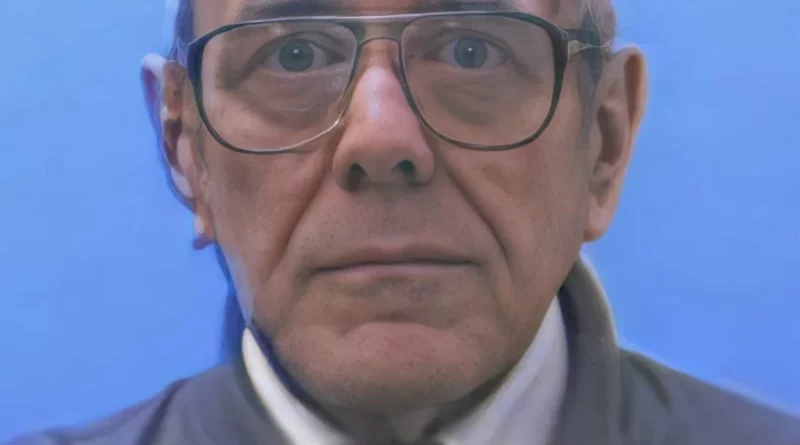The Complex Life and Death of Robert Ivan Nichols a.k.a. Joseph Newton Chandler III in Eastlake Ohio
On July 23, 2002, in the quiet suburb of Eastlake, Ohio, a man known to his neighbors as Joseph Newton Chandler III was found dead in his apartment. The cause of death was a self-inflicted gunshot wound. What seemed at first like a straightforward suicide quickly unraveled into a perplexing mystery that baffled investigators for years. Upon his death, authorities found that Joseph Newton Chandler III had been living under a stolen identity. The real Joseph Newton Chandler III had died in a car crash as a child decades earlier. The question then arose: Who was the man who had assumed Chandler’s identity, and what had driven him to take his own life?
The Discovery of the Alias
Following the suicide, investigators tried to locate family members or next of kin to notify them of Joseph Newton Chandler III’s death. As they delved deeper into his background, they were shocked to discover that the social security number he had been using belonged to a boy from Texas who had died in 1945. This revelation triggered an exhaustive investigation to determine the true identity of the man who had lived under the alias for decades.
The trail led to nothing but dead ends. There were no family ties, no friends, and no previous addresses linked to the man prior to 1978, the year he assumed the stolen identity. He had lived a remarkably private life, carefully concealing any traces of his past. The only clue investigators had was a series of mysterious and carefully guarded personal habits that suggested he had something to hide.
The Life of the Imposter
Though “Joseph Newton Chandler III” had no known close relationships, his neighbors and coworkers described him as an odd but generally unremarkable man. He lived alone in a small, cluttered apartment and worked as an electrical engineer for a few companies in the Cleveland area. Colleagues recalled him as introverted and quirky, with a particular fascination for electronics and gadgets.
One of the more bizarre incidents in Joseph Newton Chandler III’s life occurred when he went to the hospital due to an injury he claimed was caused by a vacuum cleaner. According to reports, Chandler visited a hospital in 1986, stating that he had injured his groin while attempting to repair his vacuum cleaner. The injury required stitches, and the peculiar nature of the incident added to the list of strange, unexplained moments in Chandler’s life.
He kept to himself, rarely engaging in conversations beyond the most necessary interactions. Even after winning a substantial lottery prize in 1997, he maintained his frugal lifestyle, avoiding any luxuries or social activities that might draw attention to him. The details of his daily life were methodical, and he appeared to be a man who meticulously planned every aspect of his existence.
His careful concealment of his past and his use of a false identity for over two decades begged the question: What was he hiding from? Was he running from the law, from his own family, or from something more sinister? These questions lingered as authorities searched for answers.
In 1989, investigators learned that Joseph embarked on a curious trip from Ohio to Maine to visit the L.L. Bean store in Freeport, Maine. After driving nearly 700 miles to reach the renowned outdoor retailer, Chandler pulled into the parking lot only to find it completely full. Without stepping out of his car, he immediately turned around and began the long drive back to Ohio. This seemingly bizarre journey—traveling such a great distance just to leave without shopping—added yet another layer of mystery to Chandler’s already puzzling life. His abrupt decision to leave without completing his intended errand left investigators wondering whether the trip had deeper significance, or if it was simply another example of his unusual and reclusive behavior.
Clues Left Behind After the Suicide
Following the suicide, investigators combed through Chandler’s apartment for any documents or possessions that might shed light on his true identity. They found little of significance. The apartment was sparsely decorated, and most of his possessions were ordinary. There were no family photos, no personal letters, and no clues to his origins. However, a few details hinted at the complexity of the man behind the alias.
One of the more puzzling discoveries was a receipt from a hospital in Nebraska, dating back to the late 1970s. Investigators were unable to find any connection between Chandler and Nebraska, leading them to wonder if this could be a clue to his past. In addition, he had made several purchases of survivalist gear, leading to speculation that he might have been preparing for an event or had a deep fear of persecution.
Despite these leads, nothing conclusive emerged from the investigation. The more investigators learned about Chandler’s life, the more elusive his past became.
The Lengthy Investigation
The revelation of Joseph Newton Chandler III’s stolen identity prompted a deeper investigation, spearheaded by the U.S. Marshals Service and other federal agencies. For over a decade, they pursued countless leads, searching for anyone who might recognize the man who had lived under a false name. His fingerprints were submitted to national databases, but no matches were found.
The case stumped investigators for years. There was no criminal record, no history of violence, and no apparent motive for assuming a false identity. Theories ranged from the plausible to the bizarre: Was he a fugitive from justice, a victim of trauma, or even a former spy hiding from his past? Despite the effort invested, investigators were no closer to answering these questions as the years passed.
The Breakthrough in 2016: DNA Testing
The turning point in the case came in 2016, when advancements in forensic genealogy provided a new avenue of investigation. Using DNA samples from Chandler’s remains, investigators were able to trace his lineage through public ancestry databases. This method, which had gained popularity in solving cold cases, allowed authorities to identify distant relatives of the man.
After an extensive search, genealogists were able to trace Chandler’s DNA back to a family in New Albany, Indiana. In 2018, the FBI announced that they had finally discovered the true identity of the man who had lived as Joseph Newton Chandler III: his real name was Robert Ivan Nichols.
The True Identity: Robert Ivan Nichols
Robert Ivan Nichols was a World War II veteran who had vanished from his family’s life in the 1960s. Born in 1926, Nichols had served in the U.S. Navy during the war and later worked as a draftsman. In 1965, he left a note for his family saying he was leaving for good. He disappeared without a trace and resurfaced years later under the identity of Joseph Newton Chandler III.
Investigators learned that Nichols had lived a solitary life, avoiding any form of contact with his relatives. His reasons for abandoning his family and assuming a new identity remain unclear. His surviving family members were shocked to learn of his fate, describing him as a quiet, reserved man with no history of violent behavior or mental illness.
Why Did Robert Ivan Nichols Assume a False Identity?
The discovery of Nichols’ true identity brought some answers but raised even more questions. Why did Nichols abandon his life and assume a new identity? Was he running from something or someone, or was he simply trying to escape the life he had known?
Some have speculated that Nichols might have been involved in criminal activity or witnessed something traumatic that made him fear for his safety. Others believe that he may have suffered from untreated mental health issues or post-traumatic stress disorder (PTSD) related to his experiences during World War II. However, no definitive evidence has emerged to support any particular theory.
The Unsolved Mysteries of Robert Ivan Nichols
While investigators were able to solve the mystery of Chandler’s true identity, many aspects of his life remain unexplained. What drove Nichols to sever all ties with his family and live in anonymity for decades? Why did he choose to end his life in 2002, after years of carefully maintaining his false identity?
The lack of clear answers has only fueled further speculation. Some believe that Nichols’ life as Joseph Newton Chandler III may have been part of a larger, undiscovered story. Others suggest that his decision to take his own life may have been the culmination of years of isolation and unresolved personal issues.
The Theory of Robert Ivan Nichols as the Zodiac Killer
One of the most intriguing and controversial theories surrounding Robert Ivan Nichols, who lived under the alias Joseph Newton Chandler III, is the speculation that he could have been the infamous Zodiac Killer. The Zodiac Killer was a serial killer active in Northern California in the late 1960s and early 1970s, responsible for a string of murders and cryptic letters sent to local newspapers. The case remains unsolved, and the killer’s true identity has been the subject of numerous theories and investigations for decades.
The possibility that Nichols might have been the Zodiac Killer has sparked the imagination of true crime enthusiasts and amateur sleuths alike. While the idea is largely speculative, several circumstantial details and coincidences have been pointed to as potential evidence linking Nichols to the notorious killer.
Circumstantial Evidence: Timeline and Disappearance
One of the key factors driving the theory that Nichols could have been the Zodiac Killer is the timeline of his disappearance. Nichols left his family in 1965, three years before the Zodiac’s first confirmed murder in 1968. After abandoning his family, Nichols assumed the identity of Joseph Newton Chandler III in 1978, carefully hiding his past and living under a false identity for over two decades. The theory suggests that Nichols’ decision to disappear and change identities could have been motivated by his involvement in the Zodiac killings, allowing him to evade law enforcement and start a new life.
Moreover, Nichols was a man with a military background, having served in the U.S. Navy during World War II. The Zodiac Killer also displayed a deep interest in military codes and cryptography, sending taunting letters to newspapers that included ciphers. Some proponents of the theory have speculated that Nichols’ military experience might have given him the knowledge to create the Zodiac’s ciphers, which have puzzled cryptographers and investigators for years.
Geographic Proximity and Travels
Another aspect of the theory revolves around Nichols’ possible travels during the time the Zodiac murders occurred. Nichols was known to have been in California at various points in his life, and proponents of the theory argue that he could have traveled to the Bay Area during the late 1960s and early 1970s. However, no definitive evidence has been found to place Nichols in Northern California during the specific time frame of the Zodiac murders.
Despite the lack of direct evidence, the fact that Nichols lived under a false identity and led a secretive life for decades has fueled speculation that he may have been hiding from something significant, such as his involvement in the Zodiac killings.
Behavioral Parallels
Supporters of the theory also point to certain behavioral characteristics of Nichols that align with the known traits of the Zodiac Killer. Nichols was described as a highly private and solitary man who avoided forming close relationships. He was also meticulous in concealing his past and lived a frugal, isolated lifestyle. These traits are consistent with what is known about the Zodiac Killer, who has been portrayed as a calculating individual who relished the control and anonymity he maintained throughout his killing spree.
Additionally, some have noted that Nichols exhibited signs of a troubled psychological state, which could have been indicative of deeper issues. His use of a stolen identity, his apparent fear of being discovered, and his eventual suicide in 2002 all suggest that Nichols was carrying the weight of significant personal secrets.
Physical Resemblance and Sketch Comparisons
One of the more speculative aspects of the theory involves comparing photographs of Robert Ivan Nichols to composite sketches of the Zodiac Killer. The famous sketches, based on eyewitness descriptions of the Zodiac, depict a man with glasses, a round face, and a slight build. Some true crime enthusiasts have claimed that Nichols bears a resemblance to the Zodiac sketches, particularly in terms of facial structure and the distinctive use of glasses.
While the resemblance is subjective, the theory gained some traction online due to these visual comparisons. However, it is important to note that no official law enforcement agencies have drawn any definitive connections between Nichols and the Zodiac based solely on appearance.
The Case Against the Theory
Despite the intriguing coincidences and circumstantial evidence, there is no concrete proof linking Robert Ivan Nichols to the Zodiac Killer. Law enforcement agencies have not publicly identified Nichols as a suspect in the Zodiac case, and there are several arguments against the theory.
For one, there is no direct evidence placing Nichols in Northern California during the time of the Zodiac murders. His movements in the late 1960s and early 1970s remain largely unknown, but no records or witness accounts have surfaced to definitively link him to the crime scenes.
Additionally, the Zodiac Killer’s letters displayed a level of arrogance and a desire for recognition, as the killer often taunted the public and police with his cryptic messages. Nichols, on the other hand, seemed to have no interest in drawing attention to himself, having lived a quiet, reclusive life under a stolen identity. His efforts to conceal his past and avoid interactions with others seem to contrast with the Zodiac’s need for infamy.
Finally, while the DNA technology that identified Nichols as Robert Ivan Nichols was groundbreaking, it has not been used to match his DNA to any evidence from the Zodiac crime scenes. Without a definitive DNA match or other forensic evidence, the theory remains speculative at best.
A Compelling But Unproven Theory
The idea that Robert Ivan Nichols, alias Joseph Newton Chandler III, could have been the Zodiac Killer is certainly an intriguing theory, but it is largely based on circumstantial evidence and speculation. Nichols’ mysterious life, his use of a false identity, and his disappearance from his family align with some of the characteristics attributed to the Zodiac Killer, but without concrete evidence, the theory remains in the realm of speculation.
As with many unsolved mysteries, the lack of definitive answers allows for a wide range of theories and interpretations. Nichols’ true motives for abandoning his family and assuming a new identity remain unclear, and while some believe he could have been the Zodiac Killer, the lack of conclusive evidence prevents this theory from being fully validated.
In the end, the case of Robert Ivan Nichols continues to captivate the public’s imagination, with the theory of his connection to the Zodiac Killer standing as one of many possible explanations for his secretive and enigmatic life. However, until more evidence comes to light, the true identity of the Zodiac Killer remains one of the most enduring unsolved mysteries in American criminal history.
The Impact of the Case on Cold Case Investigations
The case of Robert Ivan Nichols, alias Joseph Newton Chandler III, stands as a testament to the power of modern forensic technology, particularly the use of DNA testing and genealogy to solve long-standing mysteries. This case, along with others solved through similar methods, has reinvigorated cold case investigations across the country.
For investigators, the case highlights the importance of persistence and the willingness to explore new technologies and methods in uncovering the truth. Although many questions remain unanswered, the discovery of Nichols’ true identity provided closure to a mystery that had stumped authorities for years.
The Legacy of the Case
The story of Robert Ivan Nichols, a man who lived under a stolen identity for decades, has captivated the public and raised questions about the nature of identity, privacy, and the lengths to which people will go to escape their past. While Nichols’ motives may never be fully understood, his case serves as a reminder that even the most carefully guarded secrets can eventually come to light.
The case also underscores the human cost of unresolved trauma and the lengths people may go to isolate themselves from others. Nichols’ life, shrouded in mystery, leaves a legacy of unanswered questions that will likely continue to intrigue investigators, true crime enthusiasts, and the public for years to come.
Discover more from City Towner
Subscribe to get the latest posts sent to your email.




